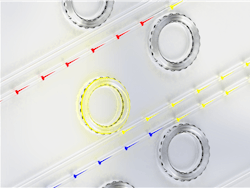Brillouin-scattering-induced transparency leads to nonreciprocal optical waveguides
Researchers from the University of Illinois at Urbana-Champaign are using Brillouin-scattering-induced transparency (BSIT) to create one-way optical waveguides; BSIT permits light to travel in the forward direction while light traveling in the backward direction is strongly absorbed.1 The technique can lead to better optical isolators and circulators.
The technique is simple, relying on just a glass microfiber and a glass sphere adjacent to it. BSIT is a form of electromagnetically induced transparency (EIT), which can be used to produce "slow light" and "fast light." EIT based on stimulated Brillouin scattering had been considered unfeasible, but the Illinois researchers were able to create phonons that last long enough for BSIT to occur.
For one-way transmission of light to occur, some sort of symmetry-breaking mechanism must be present. In the Illinois device, this mechanism is a propagating acoustic wave, which travels in only one direction and this creates nonsymmetric conditions in the waveguide.
"Light at certain wavelengths can be absorbed out of a thin optical waveguide by a microresonator—which is essentially a tiny glass sphere—when they are brought very close," explains Gaurav Bahl, an assistant professor of mechanical science and engineering at Illinois. "Through the BSIT phenomenon we showed that we can eliminate this opacity, i.e., we can make this system transparent again by adding another laser at a specially chosen wavelength nearby."
Existing nonreciprocal optical devices—for example, isolators and circulators—are exclusively built using the Faraday magneto-optic effect, which uses magnetic fields to break the time-reversal symmetry with certain specialized garnet and ferrite materials. However, these materials are challenging to obtain at the chip scale through conventional foundry processes. Magnetic fields are also sources of interference in many applications such as cold-atom microsystems. These constraints have hindered availability of Faraday effect isolators for on-chip optical systems.
"We have demonstrated a method of obtaining linear optical non-reciprocity that requires no magnets, can be implemented in any common optical material system without needing ferrites, and could be implemented today in any commercial optical foundry," says Bahl. "Brillouin isolators do already exist, but they are nonlinear devices requiring filtering of the scattered light. BSIT, on the other hand, is a linear non-reciprocal mechanism."
Slow and fast light via BSIT
"While it is already known that slow and fast light can be obtained using Brillouin scattering, our device is far smaller and uses far less power than any other previous demonstration, by several orders of magnitude," says JunHwan Kim, one of the researchers. "However, we must sacrifice bandwidth to obtain such performance."
In their studies, Bahl's research group uses the extremely minute forces exerted by light to generate and control mechanical vibrations of microscale and nanoscale devices (a field called optomechanics). In resonant microcavities, these minuscule forces can be enhanced by many orders of magnitude. They are using these phenomena to unearth new physics behind how solids, liquids, and gases interact with light.
Source: http://engineering.illinois.edu/news/article/10527
REFERENCE:
1. JunHwan Kim et al., Nature Physics (2015); doi: 10.1038/nphys3236
About the Author
John Wallace
Senior Technical Editor (1998-2022)
John Wallace was with Laser Focus World for nearly 25 years, retiring in late June 2022. He obtained a bachelor's degree in mechanical engineering and physics at Rutgers University and a master's in optical engineering at the University of Rochester. Before becoming an editor, John worked as an engineer at RCA, Exxon, Eastman Kodak, and GCA Corporation.

